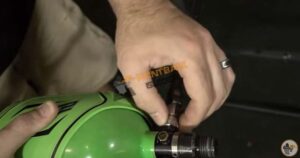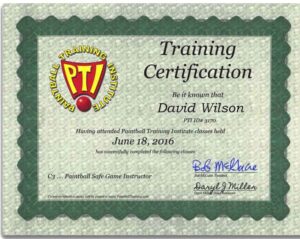Playing paintball is fun but running out of gas in the middle of a game is certainly not! And it is still worse to wait at the fill station for someone to show up and fill your gas tank.
What if we tell you that filling your HPA tank with an air compressor is easy as a breeze?
Yes! You can do it by yourself simply by taking care of a few things. Here is everything you need to know about getting your HPA tanks refilled.
But first, you must have basic knowledge about the different types of tanks you might use with your gun.
Types of Paintball Gas Tanks
There are two main types of paintball gas tanks. And there is one more that you may have not heard about. Let us talk about all of them to get familiar with the tanks.
- CO2 Tank
This is the most common and oldest type of paintball tank. If you are playing on a rental, most probably, this is what you will be getting because these tanks are easy to find and far less expensive than any other option available.
But, they have their disadvantages too. An inconsistent fire rate is the most common one. It occurs because CO2, you may be familiar with the name Carbon Dioxide, is filled in the tank in liquid form. When you start shooting, the liquid gas works by transforming into gas.
During this process of transforming from gas to liquid form, nitrogen is released. And the temperature of your gun drops. This process is also called “frosting of the gun” which leads to many problems in your gun, including an inconsistent fire rate and velocity.
- Compressed Air or HPA Tank
This is the second most common type of tank and it is getting more popular day by day. More and more upcoming paintball guns are compatible only with HPA tanks and for good reasons.
Compressed Air or High Pressure Air is simply the air available all around you, filled in your tank in a compressed form.
Because there is no transformation involved from liquid to gas, this type of tank gives a more consistent fire rate. The tank is filled with gas, and it releases gas when the gun fires.
It is not bothered by the outside temperature, as a CO2 gas tank does, and that also makes it a better option for your gun, regardless to say, it is environmentally friendly.
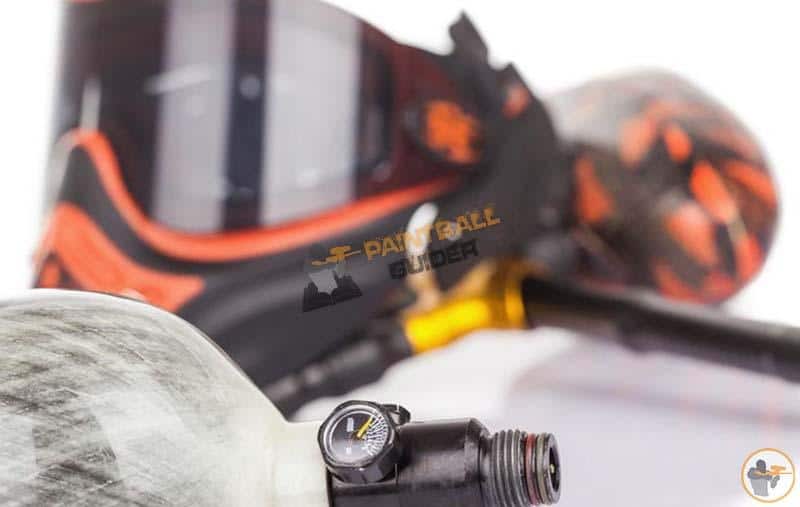
- Nitrogen Tank
These tanks are rare to find in their original form but you will hear people calling their HPA tanks “Nitrogen” tanks or even “Nitrous” simply because they find it “cool”…
Nitrogen Tanks came into existence before HPA tanks. And they vanished quite quickly because HPA took over them. Why? Let us explain because it can be a bit confusing to hear such “cool” things without knowing the truth.
As a matter of fact, the air we breathe contains 78.2 percent of Nitrogen gas. A pretty dominant gas? Yes!
Nitrogen was used in its pure form in tanks but it was realized later that the compressed air serves just the same purpose except for the fact that it is way cheaper. Some people still believe that Nitrogen works better than HPA and that is why it is still sold at some paintball fields.
But, for most of the players, it is just raged about without any actual grounds. Maybe you would like to find that out for yourself one day?
But for now, we will be sticking to the compressed air.
Pro Tip: You can fill your HPA tank with Nitrogen any day but filling your HPA tank with CO2 or vice versa is a mistake you surely do not want to make. It is not only dangerous to your tank and the gun but also for you and those around you!
Where to Fill Your Paintball Tank?
There are two obvious places to get an air tank refilled:
- Paintball Field
- Paintball Equipment Store
Despite being the CO2 air fill a more common supply, HPA tanks are getting popular day by day. Most fields are offering HPA refilling but in case you do not get it on your field, you can get it from a local paintball store for sure.
The third option is to get it refilled at your home. No, do not get it wrong! You surely cannot refill your HPA paintball tank with a manual pump. You need to buy a special setup if you are too keen on it. We will discuss the whole procedure later in the article.
Filling Your HPA Tank – A Step-by-Step Process
Filling your HPA tank is a super easy process that takes only a few seconds. All you have to do is to get familiar with different parts of your tank and also with the fill station. Here is what you need to know and consider.
What Do You Need?
Fortunately, you do not need any type of tools in order to fill your HPA tank. All you need is to have your tank and take it to a fill station. You are not even required to remove your tank from the gun if you want a quick fill. Though, you can remove it if that is what you prefer.
But, you certainly want to know what you are working with. All the Steps and differences of HPA tanks and fill stations are stated below.
Step 1: Check For the PSI of Your Tank
PSI stands for Pound-force per Square Inch. Tanks have different capacities to hold gas pressure and that is why paintball HPA tanks are further categorized into two types.
- 3000 PSI Tanks
These tanks are a budget option for those upgrading from a CO2 tank to an HPA one. Made of Aluminum, these tanks can cost you around 50 bucks, which is quite expensive compared to a CO2 tank, but they are certainly worth your money.
This tank can give you anywhere between 500 to 800 shots depending on your marker.
- 4500 PSI Tank
The other category is a 4500 PSI tank which is considered a high end product. Because it can hold much more than the 3000 PSI tank, it comes with an extra layer of protection. The Aluminum tank is covered in a carbon fiber layer to make it safer to hold all that pressure.
While filling your tank, you must check how many PSIs it can hold and never try to overfill your tank. Overfilling cannot only be harmful to your gun and the tank, but it can also cause damage to you by exploding at any time.
A few extra shots are not worth taking the risk of an exploded tank and maimed body. Both cannot give you any advantage in paintballing.
Step 2: Check the Gauge
All HPA tanks have a small gauge attached to their neck. This gauge tells you how much gas is left in the tank. Before you try to refill your tank, you need to make sure that the gauge is pointing at zero.
Pro Tip: If there is any gas left in your tank, you need to let it out before you refill it. Or the gas inside your tank is going to interfere with the gas you are filling in, making things difficult for you.
But if you know that your tank is empty and the gauge is still not pointing at zero, this indicates a broken gauge. Get it fixed as early as possible.
Pro Tip: It is also recommended to get your HPA tanks deeply inspected every five years to avoid any serious hazards.
Step 3: Attaching Your Tank to the Fill Station
After you have made sure that you are holding an HPA tank in your hand and also to how many PSIs you need to fill it to, the next step is to attach it to a fill station.
Some fields have fill stations that work for a 3000 PSI tank, and others are good for 4500 PSI tanks but, most of the time you will find one with 5000 PSI so you can fill whichever tank you have. Ask the field authorities if you are unsure about what kind of fill station they have.
Next, you have to attach the fill station to your tank’s nipple.
A fill nipple is just a valve with a tiny piston in it. When you let the gas in, its pressure pushes the piston in, and that allows gas to enter your tank.

Take the extension hose of the fill station in your one hand and hold it from its quick adapter. A quick adapter is attached to the end of the hose.
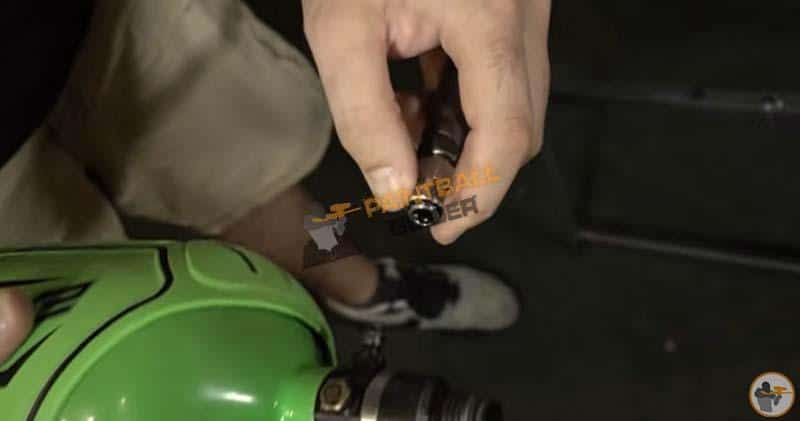
Right on the end of this adapter, you will see a collar. You pull the collar a little backward.
Take your HPA tank in the other hand, making sure the gauge is facing upwards, so you can read it, and let it climb the fill nipple.
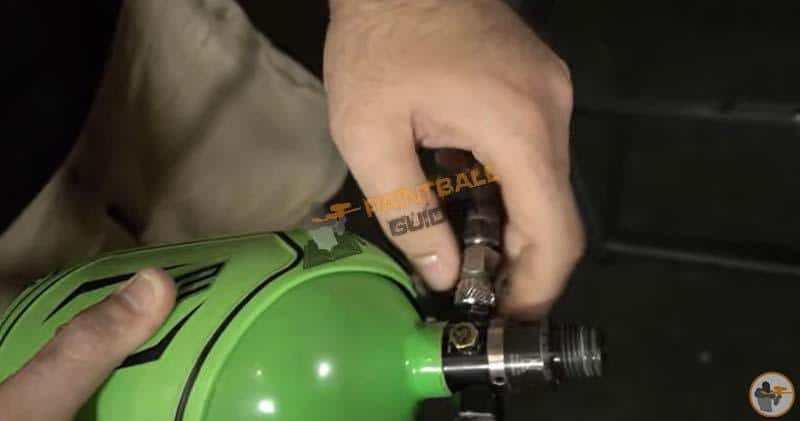
Once it is all the way fixed on the nipple, push the collar back up and make sure it spins. If the collar is spinning, it means the adapter is securely attached to your tank.
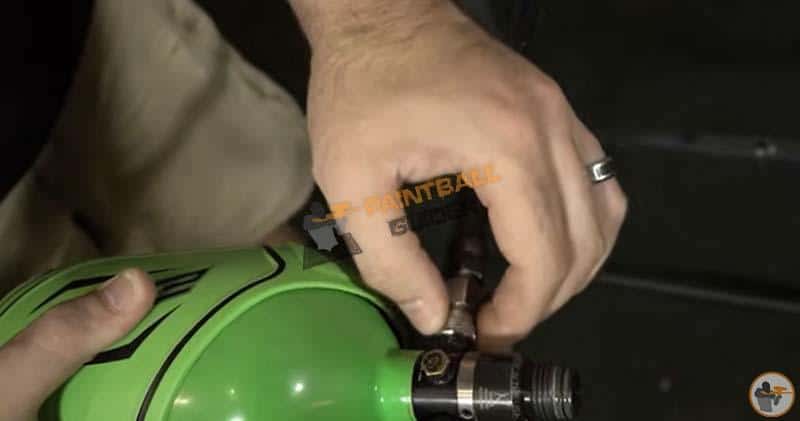
Pro Tip: Always double check the adapter is sitting securely on the fill nipple. If you make a mistake there and let the gas in, the chances are that the hose will be coming off the nipple and flying around you, smashing in anything that comes in its way with all its might.
Step 4: Time to Fill the Tank
After you have successfully attached the tank with the fill station, the only thing left is to fill it with gas. When it comes to allowing gas into your tank, there are two kinds of fill stations.
One type has got a handle or knob on them, which you need to push and the gas starts to flow.
The other type has a simple push button, you push the button and the gas starts coming its way. Either way, the task is super easy. Just push the handle or the button and you are filling.
But, while you fill the tank, you need to take care of a few things.
a) Look at Both the Gauges
Your tank has a tiny gauge on its neck. The exact same gauge is also attached to the fill station. While you are filling the gas you need to keep an eye on both gauges.
The reason behind doing this is, sometimes one of the gauges can be at fault without you knowing it.
But when you start filling up that tank, you can check if either one is not working properly and then you can rely on the one which is working. Because, as we mentioned before, overfilling your tank is something you want to avoid at all costs.
b) Don’t Try to Rush
While you are filling the tank, make sure that you are doing it slowly. There are two advantages to that.
- If you increase the pressure, your tank might get hot. The temperature changes will not allow you to fill the tank to its full capacity.
- Letting the gas in slowly gives you more control over the fill station. Filling your tank is a matter of seconds and you want to stop as soon as it reaches its full capacity to avoid the risk of overfilling.
Step 5: Remove the Hose
As soon as the gauge indicates that the tank is full, you need to release the pressure on the knob or button of the fill station. Release the pressure and you will hear the sound of gas, which means the hose is free of the gas pressure.
Pull the collar of the adapter backward, remove it from the nipple and you are done!
You can also watch these videos to make things clearer.
How to Fill an HPA Paintball Tank at Home?
Filling your HPA tank at home is not an easy option but if you feel that gas refills are costing you a lot of money, you can certainly buy your personal setup and that will surely save you money in the long run.
So, let’s know how you can do it at home and what things are required.
What Type of Filling Tank Do You Need at Home?
If you have a scuba tank at your home by any chance, you can use it to fill your HPA paintball tanks. If not, you can buy a Filling tank.
But, if you are thinking about filling your tank with an air compressor you use to fill your inflated car tires, you are quite mistaken. The tanks used to fill car tires range only from 100 to 130 PSIs, they are certainly not going to fill a tank with 3000 PSIs of air pressure.
A scuba tank is just the right type of tank to serve the purpose as it holds anywhere from 2400 to 3000 PSIs of air pressure, depending on the brand you have.
Fill Station
You can easily buy a fill station from an Online Store that can cost you anywhere from 40 to 60 Dollars.
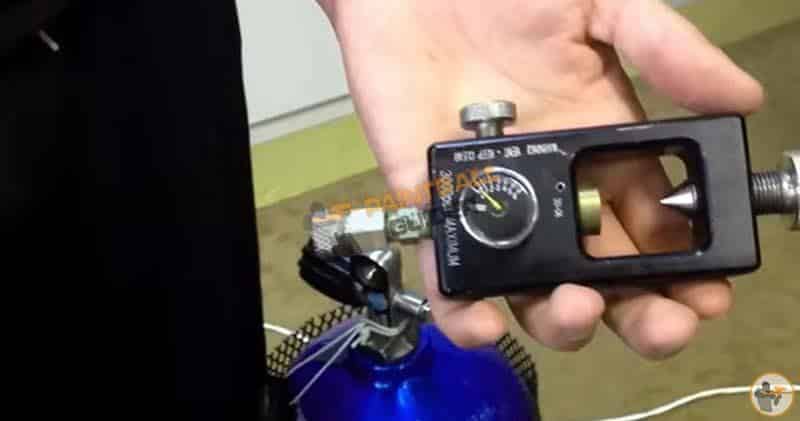
How to Fill a Paintball Tank at Home with Fill Station?
The procedure is pretty simple, you need to follow the steps given below.
- Start by loosening the screw attached at one end of the fill station.
- Secure it on the scuba tank and tighten the screw of the fill station.
- Attach the adapter of the fill station to your tank’s nipple by following the same procedure we mentioned above.
- Release the gas to your paintball tank by spinning the black knob attached to one side.
- Keep an eye on both gauges.
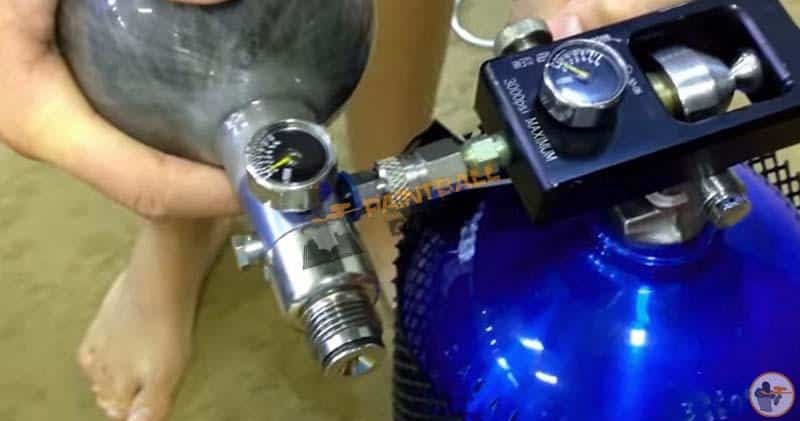
- Fill slowly.
- Turn off the gas and let the gas pressure release.
- Remove the tank and you are done.
- Refill your tank just as many times as you want without the trouble of going to a paintball store or spending money each time you need a refill.
- Take help from this video if there is any confusion.
Wrapping Up
We will conclude by saying that filling your HPA tank is one of the easiest things involved in the paintball journey. You can do the job in a matter of seconds but the risks involved can make it daunting for you.
All you are required to do is to get familiar with the stuff you are dealing with and you cannot go wrong with your refills. Know what type of tank you are using and what type of fill station you are dealing with. Once you have done that, there is nothing difficult about the entire procedure.
Frequently Asked Questions (FAQs)
Can I fill CO2 in my HPA Paintball tank?
Certainly not. You cannot fill CO2 in your HPA tank or vice versa. Both tanks are made different and work differently. Filling the tanks with the wrong type of gas can cause damage to the tank, and problems for your gun, and also puts your safety in danger.
Can I fill my HPA tank with a hand-pumped air compressor?
Though HPA is just the gas around you, the pressure is so high that you can never possibly fill it with a manual pump. The entire process may take ages but you are certainly going to tire yourself in the first few minutes. That is why it is not even worth your effort.
Why are 4500 PSI Paintball tanks made of Carbon fiber?
4500 PSI tanks have a carbon fiber covering in addition to an aluminum main body to make them extra strong. The pressure inside a 4500 PSI tank is so high that you have to make it a super strong tank to hold that pressure.
Does a 4500 PSI Paintball gas tank help to shoot faster?
The PSI of a tank does not determine the speed of shooting. No matter what type of tank you have attached to your gun, it is going to fire at a 700 to 800 PSI rate. That means a higher PSI tank like a 4500 PSI tank can give you more shots than a 3000 PSI tank but none of the tanks is going to make your fire rate faster or slower.
How long does it take to refill a paintball tank?
The whole procedure takes only a few seconds if you are familiar with the stuff you are dealing with.
To what extent can I overfill my HPA Paintball tank?
You have to avoid overfilling at any cost and to any extent. An overfilled tank can cause damage to your tank and gun at the minimum, or it may explode and result in a fatal injury at the maximum. A few extra PSIs do not matter but why take a risk?






